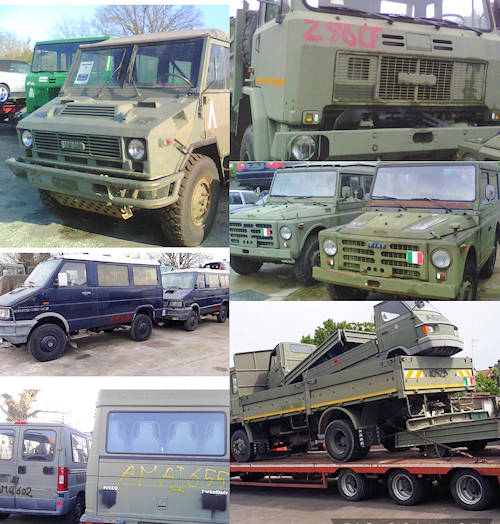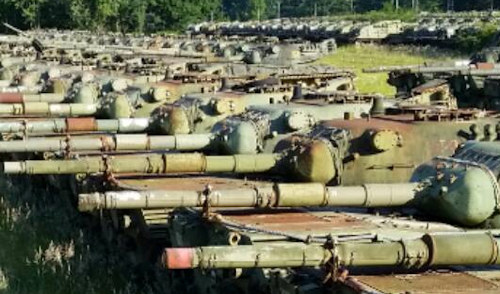Although exaggerated, the purchase of an SUV for city use is certainly a sort of guarantee against micro parking bumps or pavements that are a bit too high. But there are those who would like to park in his garage, perhaps near a luxury sedan status symbol, a real clearly demilitarized tank. At this point, at least for micro shocks, others should be concerned as long as those caused by the crawler can be defined as "micro".
A achievable desire?
The provisions of the law on armaments and armored vehicles at the end of the military operating cycle are very clear, as confirmed by an army colonel and, in his opinion, it is impossible to elude them. Despite the difficulties in finding news about it, we will dissolve some legitimate questions and bring to light some hidden truth.
The perception I had in this research is that collectors' ingenuity often plays a prevalent role and not infrequently crosses with an aura of institutional mystery, despite the news being free. A reality mostly Italian but we have already said this several times.

Logistics, tactics and war, the differences
For use in civil protection rather than use as a work vehicle or even to treat yourself to a very alternative private vehicle, the purchase of former military vehicles, see the Campagnola, follows very specific paths. The auctions, the purchase at the departments with the due and selected accreditations or the sales areas for private individuals, often demolitioners, who acquire by tender important lots of vehicles that have reached the end of their operational life.
These acquisitions that relate exclusively to non-armored tactical or logistic, or means that cannot determine a subsequent threat, eg: ACM80, ACTL, Bus 370 or Cacciamali, Daily, Ar76 and 90 etc., are part of that interesting pool of vehicles used perhaps with low mileage. Real opportunities to take home or repaint them for subsequent noble uses, including rescue.
There are specific regulations that must be applied when a vehicle leaves the barracks. Thanks to a note from the person in charge of the proceedings, chief Business Unit "Land Vehicles and Aircraft" of the Ministry of Defense, I will list the military details that must necessarily be eliminated before conversion to civilian means.
They must be removed: darkened lighting system; • auxiliary emergency starting socket (bipolar or coaxial); • STANAG 4101 tow hook; • Ward / support arm of the Department; • individual armament supports; • radio antenna supports and cables; wiring / supports for power supply / installation of radio equipment; • NBC reclamation apparatus and relative support; • STANAG and Department identification banners; • runflat tire device (toroid), where present; • automatic tire inflation system (téléflow / CTIS), where present; • riot control grids. • cover all military symbols with paint, interrupt the green livery with splashes of paint of other colors. And yet: - the vehicles in the protected and / or armored version, at the time of their delivery, will be demilitarized at the expense of the respective EI bodies as per the circular of the SMDIV Rep. prot. M_D SSMD of 28 January 2016; - the vehicles in the protected and / or armored version, at the time of their declaration of disuse and if it is not possible to definitively eliminate the protections and / or the armor, must necessarily be scrapped, as established by the Circ.n.3 / 2 / 1608 of the Motorization and Fuel Directorate General.

Surely the eye will have fallen on the procedure reserved for armored vehicles included in the category of war. A very delicate subject and requested by our readers, for which we wanted to offer you this survey.
CFE: Treaty for the reduction and limitation of conventional armed forces in Europe
In light of this treaty, you will understand why the officer (EI) was imperative about the current regulations. A parallel line of “private” means would become destabilizing at the international level, circumventing the provisions of the agreement.
This is an international officialization of 114 pages, signed in '90 between the member countries of NATO and the former Warsaw Pact, about a controlled balancing of conventional weapons and armaments that must be present in the various states in well-defined numbers. The CFE Treaty, Conventional Armed Forces in Europe, follows a guaranteed perspective, so that no member country can pose a threat to others.
A very detailed treaty that, in addition to the deployment in the ATTU area - the Flank Agreement - of tanks and armaments, establishes the management of the demilitarization of classified armored vehicles alienated o out order.

The sale of an alienated tank like those parked in the military area of Lenta, VC, a space subject to the treaty, can take place only as scrap pieces, or deactivated by donation or purchase reserved only to public bodies rather than associations or museums, which, however, must bear the costs of demilitarization before using it; perhaps as an ornament to a war memorial in a public square.
The vehicles of the Second World War, already resident in Italy and not covered by the CFE Treaty, fall under the laws and circulars of the Interior Minister - 185 / 90 - which clearly establish what to do to deactivate and demilitarize a weapon.
Site of reduction and conversions
The reduction area of our FFAAs is in Lenta and, the main reason why the Army does not sell demilitarized tanks or armored cars to private individuals, lies in the excessive costs to be incurred for the transformation into civilian vehicles, for example in tractors, dozer or generator sets.
However, if the M113 wagons represent an interesting source of aluminum supply, it is also true that some units of this wagon - VCC1 and M113 - gave rise to the tactical amphibian ARISGATOR produced by ARIS SpA.

The sale, apart from bureaucracy, guarantees in any case a rapid economic return to the FFAA and, in addition to a real price list, some armored vehicles such as Centaur 8x8 may be resold to countries not subject to the CFE and which prove to comply with international conventions.
The transformation into museum specimens is well specified on the Treaty. The problem of selling to private individuals, as it is easily understandable, represents given the exorbitant costs and the procedures, only a narrow range of market limited only to the exemplary converted (but without market) and those museum (in case of private museum).
The demolition must follow precise procedures, and on the basis of the treaty, the presence of inspectors designated for supervision is optional.
For explosion, shearing and percussion: these are the meticulous guidelines for the reduction in scrap of a tank. For reasons of space, I report only three demolition procedures: an explosive charge is placed outside the hull between the 3 ° and 4 ° roller in the case of total 6 avoiding areas with welds present. Positioning will take place near the turret and hull. The second charge will be positioned inside the hull in correspondence, but offset, with respect to the first one. Mechanical shearing of the firearm in two parts at a distance from the breech block not exceeding 100 millimeters. And again, for percussion, the hull and turret must be deformed so that their width is reduced by at least 20%.

But there's more; in negotiation for an armored OT 64 SKOT R-2M 8x8
For e.mail, I pretended to be a customer interested in purchasing an amphibious armored 8x8 in an eastern country and, just to be on the lookout for anything, I chose it specifically with an 14.5 mm cannon. Despite the fact that the CFE treaty is in force, which in fact "numbers the means", all it takes is money and a passport to buy a war, the important thing is that it remains within the State of purchase.
Among the different and interesting offers such as the T34 or 55 rather than a URAL 4320 in good condition or a Krug, I chose a compromise (for consumption ...) the more modest Skot R-2m for sale after checking a price of 6 thousand EUR.
During the exchange of news, I asked the kind contact person for transport information in Italy. Even though he vague, he replied that the vehicle would be delivered "turnkey" with all the documents in order as well as an additional transport service on customer request.
With some embarrassment, I asked the traffic police of Bolzano - "Good morning, I should bring a tank to Italy ..." - if the transport falls within the arts 168 of the CDS, the regulation on the transport of dangerous materials in ADR, such as the transport of gas, hydrocarbons, acids, explosives from quarry. They promptly cited specific regulations pertaining to the Defense and Ministry of the Interior. Among other things, without a registration and license plate, they do not even have the characteristics to fall into the category of agricultural or operating machines.

Remember
During an artillery exercise, I still remember the characteristic whistle of the 10 MTU biturbo cylinders from 37.4 cc and well 830 cv, which pushed the A1 Leopard at high speed over the dunes. Feeling even the gear shifts, I was almost impressed to see the important 40 ton mass lift off the ground.
The A1 Leopard is very sought after and on the Lenta square and there are around 700 at the price of 30 thousand euro each. Interesting is the operational limitation imposed on the turret during the cold war, eliminated after the '90 with the A5 version.
As usual, a special dedication to a glorious Army unit dissolved in the '95: the 114 infantry regiment Mantova di Tricesimo UD, Patussi barracks "With ancient virtue for new glories"
Images: Giorgio Bianchi / web / Google Earth / Rai












